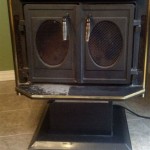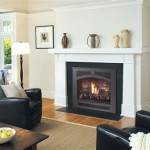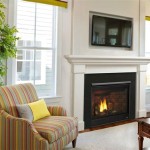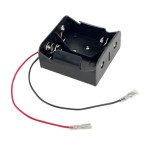Fireplace Insert Wood With Blower: Maximizing Efficiency and Comfort
A fireplace insert wood with blower is a highly effective heating appliance designed to fit directly into an existing masonry or factory-built fireplace. It offers a significant upgrade from traditional open fireplaces, providing enhanced heating efficiency, reduced emissions, and improved overall safety. The integration of a blower system further enhances the performance of the insert, distributing heat more evenly and effectively throughout the room.
The primary function of a fireplace insert is to convert an inefficient open fireplace into a closed combustion system. Traditional fireplaces lose a substantial amount of heat up the chimney, often drawing warm air out of the room. Fireplace inserts, on the other hand, are designed to trap and radiate heat into the living space. The addition of a blower significantly amplifies this effect, making the wood-burning experience not just aesthetically pleasing but also a practical and cost-effective heating solution.
Selecting the correct fireplace insert wood with blower requires careful consideration of several factors, including the size of the fireplace opening, the heating requirements of the space, and the desired aesthetic. Proper installation is crucial to ensure safe and efficient operation, and regular maintenance is necessary to prolong the lifespan of the appliance and maintain its optimal performance.
Key Features and Benefits of a Fireplace Insert Wood With Blower
Fireplace inserts with blowers offer a multitude of benefits compared to traditional open fireplaces. These advantages stem from both the closed combustion design and the forced-air circulation provided by the blower system.
Enhanced Heating Efficiency: Open fireplaces are notoriously inefficient, with a large portion of the heat generated escaping up the chimney. Fireplace inserts significantly reduce this heat loss by creating a closed combustion chamber. This design allows for more complete combustion of the wood, extracting more heat energy from each log. The blower system then distributes this heat more effectively throughout the room, preventing heat stratification and ensuring a more consistent temperature.
The efficiency of a fireplace insert is typically measured using a percentage rating. Higher efficiency ratings indicate that a greater proportion of the heat generated is being utilized to warm the room, rather than being lost up the chimney. Many modern fireplace inserts achieve efficiency ratings of 70% or higher, representing a significant improvement over traditional open fireplaces, which often have efficiencies below 20%.
Reduced Emissions: Environmental concerns are increasingly important, and fireplace inserts offer a cleaner burning solution compared to traditional fireplaces. The closed combustion design promotes more complete combustion, which reduces the amount of smoke and pollutants released into the atmosphere. The higher temperatures within the combustion chamber also help to break down harmful gases and particles.
Many fireplace inserts are certified by the Environmental Protection Agency (EPA) to meet stringent emission standards. These certified models are designed to burn cleaner and produce significantly less particulate matter than non-certified fireplaces. Using a certified fireplace insert can contribute to improved air quality and a reduced environmental impact.
Improved Safety: Open fireplaces pose several safety risks, including the potential for sparks and embers to escape and ignite nearby flammable materials. Fireplace inserts provide a safer alternative by containing the fire within a closed chamber. This reduces the risk of sparks and embers escaping, and it also prevents creosote buildup in the chimney, which can lead to chimney fires. The insert itself is also typically constructed from durable materials that are designed to withstand high temperatures and prolonged use.
Furthermore, the blower system can help to prevent overheating of the fireplace surround. By circulating air around the insert, the blower helps to dissipate heat and prevent excessive temperatures from building up on the surrounding walls and mantel. This reduces the risk of damage to the surrounding structure and enhances the overall safety of the installation.
Selecting the Right Fireplace Insert Wood With Blower
Choosing the appropriate fireplace insert wood with blower is a crucial step in ensuring optimal heating performance and satisfaction. Several factors must be considered to make an informed decision.
Fireplace Opening Size: The dimensions of the existing fireplace opening are a primary consideration. Fireplace inserts are designed to fit snugly within the fireplace, and it is essential to choose a model that is appropriately sized for the available space. Measuring the height, width, and depth of the firebox is crucial. Allow for adequate clearance around the insert for proper ventilation and installation. Consulting with a professional installer can help ensure accurate measurements and proper fit.
Heating Requirements: Determining the heating requirements of the space is essential for selecting an insert with sufficient BTU (British Thermal Unit) output. BTU is a measure of the amount of heat energy produced by the insert. The required BTU output will depend on factors such as the size of the room, the insulation levels of the building, and the climate. A larger room with poor insulation will require a higher BTU output than a smaller, well-insulated room.
Manufacturers typically provide BTU output ratings for their fireplace inserts. It is advisable to choose an insert with a BTU output that is slightly higher than the estimated heating requirements to ensure adequate heating capacity, especially during periods of extreme cold weather. Consulting with a heating professional can help determine the appropriate BTU output for specific heating needs.
Blower Specifications: Blower specifications play a vital role in the heat distribution capacity of the insert. The blower's CFM (cubic feet per minute) rating indicates the volume of air it can move. A higher CFM rating implies that the blower can circulate more air, facilitating better heat distribution across a larger area. Consider the blower's noise level alongside its CFM rating. A quiet blower is often preferable, especially in living spaces where noise can be disruptive. Look for models with variable speed controls, granting you more control over airflow and noise levels.
Aesthetics and Style: While functionality is paramount, the aesthetic appeal of the fireplace insert is also an important consideration. Fireplace inserts are available in a variety of styles and finishes to complement different home décor. Consider the overall style of the room and choose an insert that blends seamlessly with the existing aesthetic. Factors such as the color, material, and design of the insert should be carefully considered. Some inserts feature decorative surrounds or trim kits that allow for further customization.
Installation and Maintenance of a Fireplace Insert Wood With Blower
Proper installation and regular maintenance are critical for ensuring the safe and efficient operation of a fireplace insert wood with blower. These steps will extend the lifespan of the appliance and maximize its heating performance.
Professional Installation: Installation of a fireplace insert should always be performed by a qualified professional. Improper installation can lead to safety hazards, such as gas leaks, carbon monoxide poisoning, and chimney fires. A professional installer will have the necessary knowledge and experience to ensure that the insert is properly connected to the chimney, that all safety clearances are met, and that the blower system is correctly wired and functioning.
The installation process typically involves preparing the fireplace opening, installing a chimney liner to ensure proper venting, connecting the insert to the chimney, and installing the blower system. A professional installer will also perform a thorough inspection of the installation to ensure that it meets all applicable safety codes and regulations.
Regular Cleaning: Regular cleaning is essential for maintaining the efficiency and safety of a fireplace insert. Creosote, a flammable byproduct of wood burning, can accumulate in the chimney and increase the risk of chimney fires. The chimney should be inspected and cleaned at least once a year, or more frequently if the insert is used regularly. The frequency of cleaning will depend on factors such as the type of wood burned, the burning habits, and the design of the chimney.
The insert itself should also be cleaned regularly to remove ash and debris. The glass door should be cleaned with a specialized glass cleaner to remove soot and creosote buildup. The blower system should be inspected and cleaned periodically to ensure proper airflow. Dust and debris can accumulate on the blower motor and fan blades, reducing its efficiency and potentially causing it to overheat.
Chimney Inspection: Annual chimney inspections are essential to identify potential problems, such as cracks, leaks, or blockages. A qualified chimney sweep can perform a thorough inspection of the chimney and identify any necessary repairs. Addressing these issues promptly can prevent more serious problems from developing, such as chimney fires or carbon monoxide leaks.
Wood Selection: The type of wood burned can significantly impact the performance and emissions of the fireplace insert. Seasoned hardwoods, such as oak, maple, and ash, are the best choice for burning in a fireplace insert. These woods burn hotter and cleaner than softwoods, such as pine and fir. Avoid burning green or wet wood, as this will produce more smoke and creosote. Store wood in a dry, well-ventilated area to ensure that it is properly seasoned before burning.
By adhering to these installation and maintenance guidelines, users can ensure that their fireplace insert wood with blower provides years of safe, efficient, and comfortable heating.

Inserts Wood Osburn 2200 Insert With Blower Ob02201

Ventis Hei240 Wood Burning Insert

T25i Timberwolf Wood Fireplace Insert Hearth Stove Patio

Napoleon Epi3 Wood Fireplace Insert Inserts By

Why A Wood Burning Fireplace Insert Bethesda Md Service

Breckwell Wood Fireplace Insert Sw180i

Premium Wood Fireplace Inserts Made In Usa Lopi Stoves

35 Ruby Traditional Intellifire Touch Direct Vent Fireplace Insert Blower And Remote Electronic Ignition Majestic

Wood Burning Fireplace Inserts Insert Installation

Osburn Stratford Ii High Efficiency Wood Fireplace Woodland Direct








